Rostige Liebe
Portfolio. American Graffiti von George Lucas aus dem Jahre 1973 zählt zu den ersten Roadmovies überhaupt. Er handelt von Fastfood, Freiheit und Autorennen und lässt schon früh erkennen, dass die Amerikaner eine ganz besondere Liebe für ihre Autos empfinden, die sogar über den Tod hinaus geht. Dieter Klein zeigt sie uns.

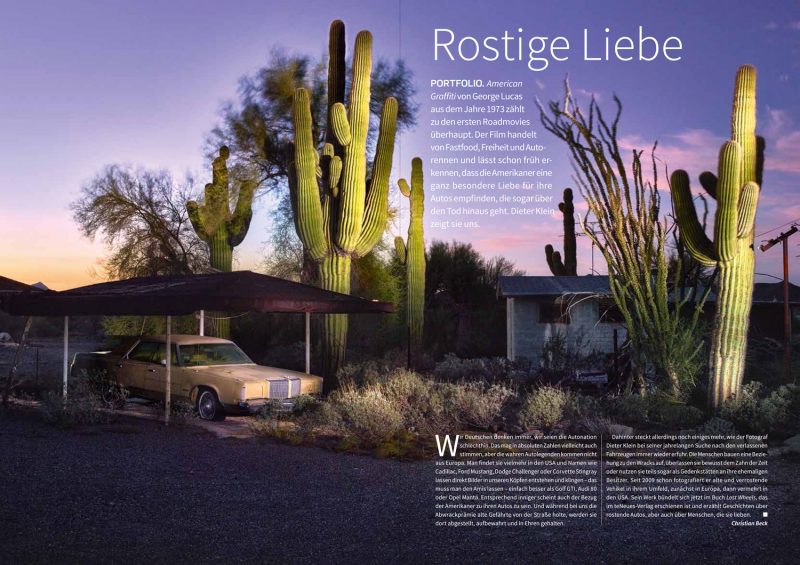
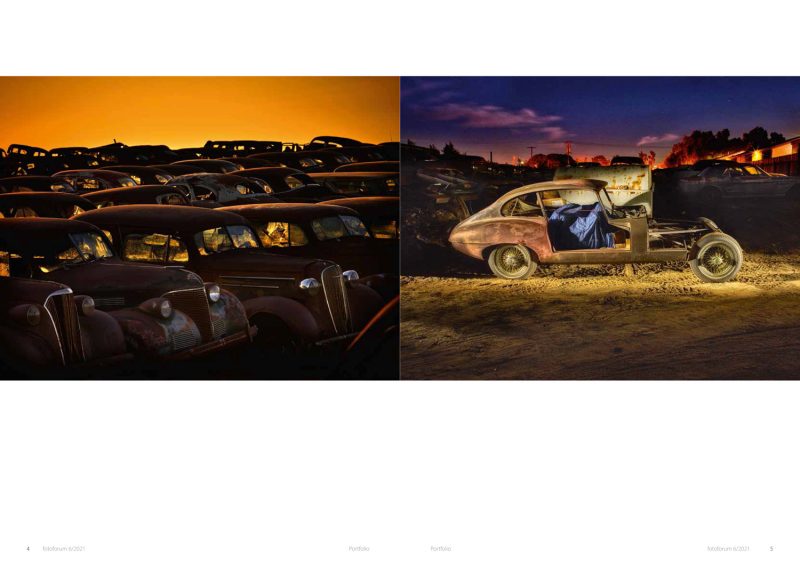
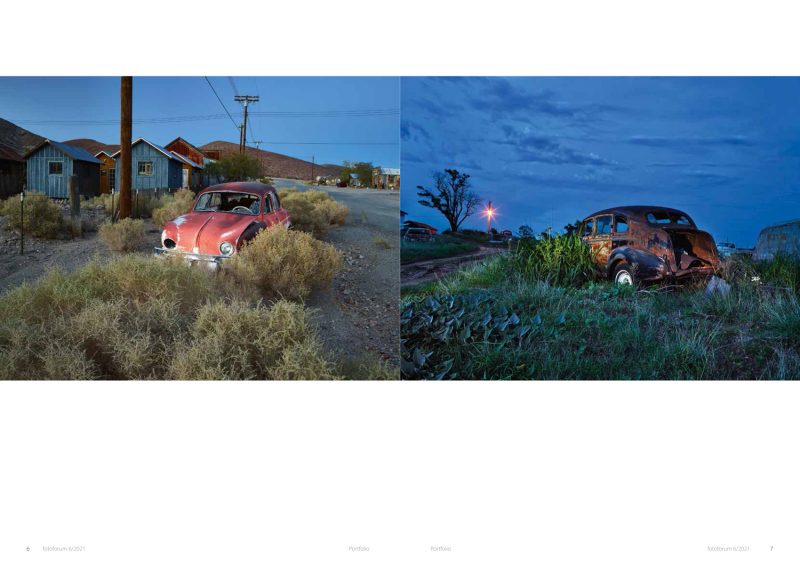
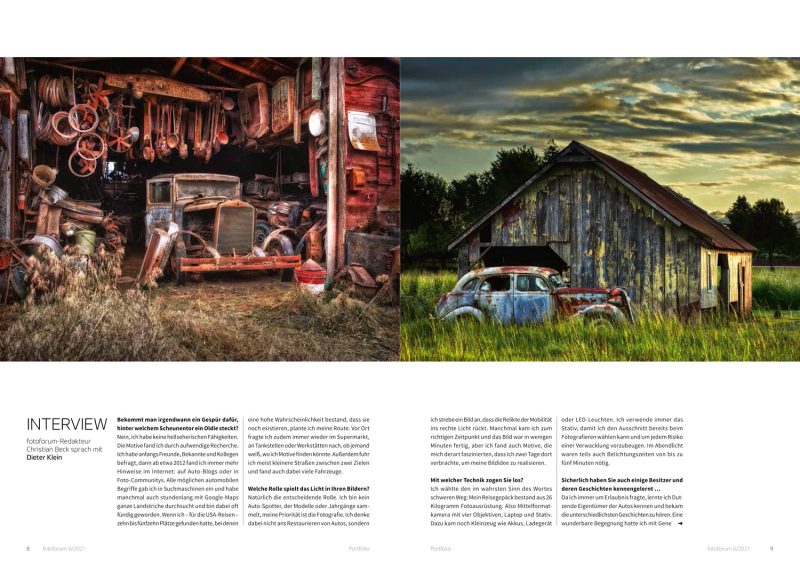
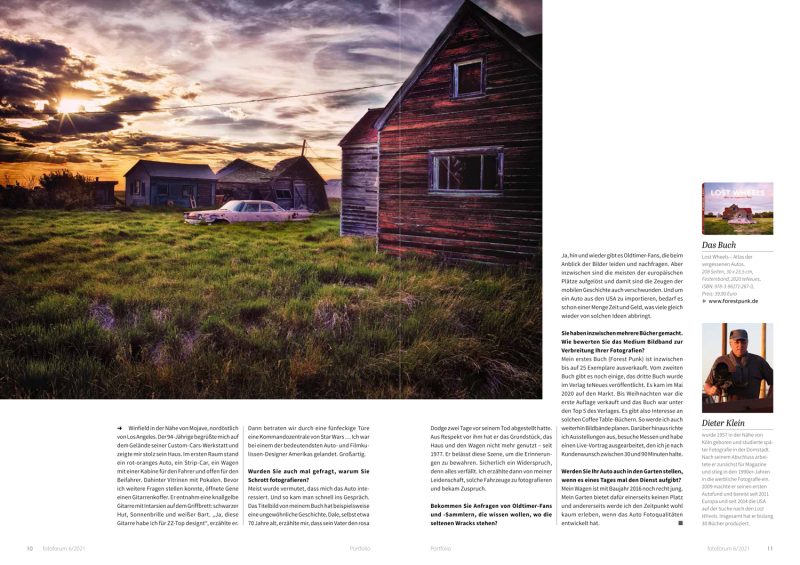
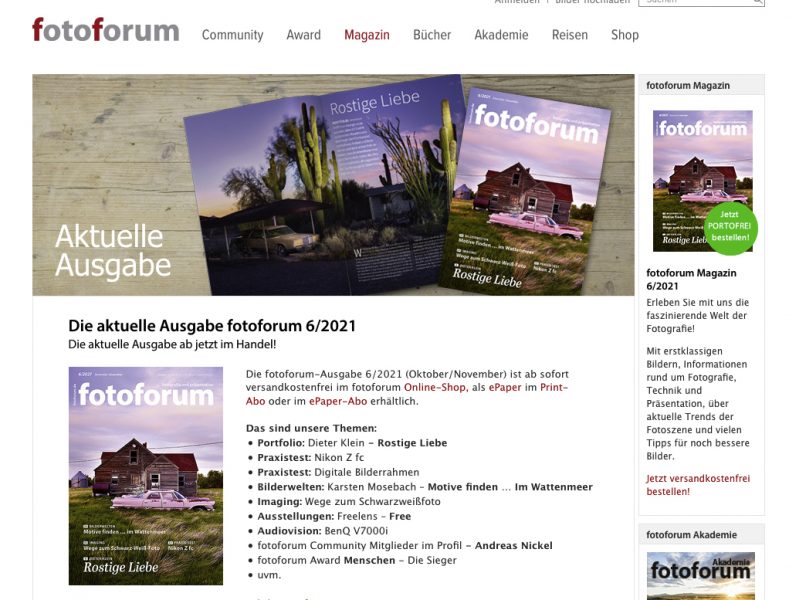
Wir Deutschen denken immer, wir seien die Autonation
schlechthin. Das mag in absoluten Zahlen vielleicht auch
stimmen, aber die wahren Autolegenden kommen nicht
aus Europa. Man findet sie vielmehr in den USA und Namen wie
Cadillac, Ford Mustang, Dodge Challenger oder Corvette Stingray
lassen direkt Bilder in unseren Köpfen entstehen und klingen – das
muss man den Amis lassen – einfach besser als Golf GTI, Audi 80
oder Opel Manta. Entsprechend inniger scheint auch der Bezug
der Amerikaner zu ihren Autos zu sein. Und während bei uns die
Abwrackprämie alte Gefährte von der Straße holte, werden sie
dort abgestellt, aufbewahrt und in Ehren gehalten.
Dahinter steckt allerdings noch einiges mehr, wie der Fotograf
Dieter Klein bei seiner jahrelangen Suche nach den verlassenen
Fahrzeugen immer wieder erfuhr. Die Menschen bauen eine Beziehung
zu den Wracks auf, überlassen sie bewusst dem Zahn der Zeit
oder nutzen sie teils sogar als Gedenkstätten an ihre ehemaligen
Besitzer. Seit 2009 schon fotografiert er alte und verrostende
Vehikel in ihrem Umfeld, zunächst in Europa, dann vermehrt in
den USA. Sein Werk bündelt sich jetzt im Buch Lost Wheels, das
im teNeues-Verlag erschienen ist und erzählt Geschichten über
rostende Autos, aber auch über Menschen, die sie lieben.
Christian Beck
INTERVIEW
fotoforum-Redakteur
Christian Beck sprach mit
Dieter Klein
Bekommt man irgendwann ein Gespür dafür,
hinter welchem Scheunentor ein Oldie steckt?
Nein, ich habe keine hellseherischen Fähigkeiten.
Die Motive fand ich durch aufwendige Recherche.
Ich habe anfangs Freunde, Bekannte und Kollegen
befragt, dann ab etwa 2012 fand ich immer mehr
Hinweise im Internet: auf Auto-Blogs oder in
Foto-Communitys. Alle möglichen automobilen
Begriffe gab ich in Suchmaschinen ein und habe
manchmal auch stundenlang mit Google-Maps
ganze Landstriche durchsucht und bin dabei oft
fündig geworden. Wenn ich – für die USA-Reisen –
zehn bis fünfzehn Plätze gefunden hatte, bei denen
eine hohe Wahrscheinlichkeit bestand, dass sie
noch existieren, plante ich meine Route. Vor Ort
fragte ich zudem immer wieder im Supermarkt,
an Tankstellen oder Werkstätten nach, ob jemand
weiß, wo ich Motive finden könnte. Außerdem fuhr
ich meist kleinere Straßen zwischen zwei Zielen
und fand auch dabei viele Fahrzeuge.
Welche Rolle spielt das Licht in Ihren Bildern?
Natürlich die entscheidende Rolle. Ich bin kein
Auto-Spotter, der Modelle oder Jahrgänge sammelt,
meine Priorität ist die Fotografie. Ich denke
dabei nicht ans Restaurieren von Autos, sondern
ich strebe ein Bild an, dass die Relikte der Mobilität
ins rechte Licht rückt. Manchmal kam ich zum
richtigen Zeitpunkt und das Bild war in wenigen
Minuten fertig, aber ich fand auch Motive, die
mich derart faszinierten, dass ich zwei Tage dort
verbrachte, um meine Bildidee zu realisieren.
Mit welcher Technik zogen Sie los?
Ich wählte den im wahrsten Sinn des Wortes
schweren Weg: Mein Reisegepäck bestand aus 26
Kilogramm Fotoausrüstung. Also Mittelformatkamera
mit vier Objektiven, Laptop und Stativ.
Dazu kam noch Kleinzeug wie Akkus, Ladegerät
oder LED-Leuchten. Ich verwende immer das
Stativ, damit ich den Ausschnitt bereits beim
Fotografieren wählen kann und um jedem Risiko
einer Verwacklung vorzubeugen. Im Abendlicht
waren teils auch Belichtungszeiten von bis zu
fünf Minuten nötig.
Sicherlich haben Sie auch einige Besitzer und
deren Geschichten kennengelernt …
Da ich immer um Erlaubnis fragte, lernte ich Dutzende
Eigentümer der Autos kennen und bekam
die unterschiedlichsten Geschichten zu hören. Eine
wunderbare Begegnung hatte ich mit Gene
Winfield in der Nähe von Mojave, nordöstlich
von Los Angeles. Der 94-Jährige begrüsste mich auf
dem Gelände seiner Custom-Cars-Werkstatt und
zeigte mir stolz sein Haus. Im ersten Raum stand
ein rot-oranges Auto, ein Strip-Car, ein Wagen
mit einer Kabine für den Fahrer und offen für den
Beifahrer. Dahinter Vitrinen mit Pokalen. Bevor
ich weitere Fragen stellen konnte, öffnete Gene
einen Gitarrenkoffer. Er entnahm eine knallgelbe
Gitarre mit Intarsien auf dem Griffbrett: schwarzer
Hut, Sonnenbrille und weißer Bart. „Ja, diese
Gitarre habe ich für ZZ-Top designt“, erzählte er.
Dann betraten wir durch eine fünfeckige Türe
eine Kommandozentrale von Star Wars … Ich war
bei einem der bedeutendsten Auto- und Filmkulissen-
Designer Amerikas gelandet. Großartig.
Wurden Sie auch mal gefragt, warum Sie
Schrott fotografieren?
Meist wurde vermutet, dass mich das Auto interessiert.
Und so kam man schnell ins Gespräch.
Das Titelbild von meinem Buch hat beispielsweise
eine ungewöhnliche Geschichte. Dale, selbst etwa
70 Jahre alt, erzählte mir, dass sein Vater den rosa
Dodge zwei Tage vor seinem Tod abgestellt hatte.
Aus Respekt vor ihm hat er das Grundstück, das
Haus und den Wagen nicht mehr genutzt – seit
1977. Er belässt diese Szene, um die Erinnerungen
zu bewahren. Sicherlich ein Widerspruch,
denn alles verfällt. Ich erzählte dann von meiner
Leidenschaft, solche Fahrzeuge zu fotografieren
und bekam Zuspruch.
Bekommen Sie Anfragen von Oldtimer-Fans
und -Sammlern, die wissen wollen, wo die
seltenen Wracks stehen?
Ja, hin und wieder gibt es Oldtimer-Fans, die beim
Anblick der Bilder leiden und nachfragen. Aber
inzwischen sind die meisten der europäischen
Plätze aufgelöst und damit sind die Zeugen der
mobilen Geschichte auch verschwunden. Und um
ein Auto aus den USA zu importieren, bedarf es
schon einer Menge Zeit und Geld, was viele gleich
wieder von solchen Ideen abbringt.
Sie haben inzwischen mehrere Bücher gemacht.
Wie bewerten Sie das Medium Bildband zur
Verbreitung Ihrer Fotografien?
Mein erstes Buch (Forest Punk) ist inzwischen
bis auf 25 Exemplare ausverkauft. Vom zweiten
Buch gibt es noch einige, das dritte Buch wurde
im Verlag teNeues veröffentlicht. Es kam im Mai
2020 auf den Markt. Bis Weihnachten war die
erste Auflage verkauft und das Buch war unter
den Top 5 des Verlages. Es gibt also Interesse an
solchen Coffee Table-Büchern. So werde ich auch
weiterhin Bildbände planen. Darüber hinaus richte
ich Ausstellungen aus, besuche Messen und habe
einen Live-Vortrag ausgearbeitet, den ich je nach
Kundenwunsch zwischen 30 und 90 Minuten halte.
Werden Sie Ihr Auto auch in den Garten stellen,
wenn es eines Tages mal den Dienst aufgibt?
Mein Wagen ist mit Baujahr 2016 noch recht jung.
Mein Garten bietet dafür einerseits keinen Platz
und andererseits werde ich den Zeitpunkt wohl
kaum erleben, wenn das Auto Fotoqualitäten
entwickelt hat.
Dieter Klein
wurde 1957 in der Nähe von
Köln geboren und studierte später
Fotografie in der Domstadt.
Nach seinem Abschluss arbeitete
er zunächst für Magazine
und stieg in den 1990er-Jahren
in die werbliche Fotografie ein.
2009 machte er seinen ersten
Autofund und bereist seit 2011
Europa und seit 2014 die USA
auf der Suche nach den Lost
Wheels. Insgesamt hat er bislang
30 Bücher produziert.
-.-
We Germans always think that we are the auto
nation par excellence. That may be true in absolute terms, but the
but the real car legends do not come from Europe.
from Europe. Rather, they can be found in the USA and names like
Cadillac, Ford Mustang, Dodge Challenger or Corvette Stingray
immediately conjure up images in our minds and sound – you have to give the
sound better than Golf GTI, Audi 80 or Opel Manta.
or Opel Manta. The Americans‘ relationship to their cars also seems
to their cars seems to be correspondingly more intimate. And while the
scrappage scheme took old cars off the road, they are parked, stored
there they are parked, stored and cherished.
But there’s a lot more to it than that, as photographer
Dieter Klein learned over and over again in his years of searching for abandoned
vehicles over and over again. People build up a relationship
to the wrecks, deliberately leaving them to the ravages of time
or even use them as memorials to their former owners.
owners. Since 2009, he has been photographing old and rusting vehicles in their
vehicles in their surroundings, first in Europe, then increasingly in the
the USA. His work is now bundled in the book Lost Wheels, which was
published by teNeues, tells stories about rusting cars, but also about
rusting cars, but also about people who love them.
Christian Beck
INTERVIEW
fotoforum editor
Christian Beck spoke with
Dieter Klein
Do you get a feeling for it at some point,
behind which barn door an oldie is?
No, I don’t have any clairvoyant abilities.
I found the motifs through extensive research.
In the beginning, I asked friends, acquaintances and colleagues.
colleagues, and then, from around 2012, I found more and more
clues on the Internet: on car blogs or in photo communities.
photo communities. I entered all kinds of automotive
terms into search engines and sometimes spent
sometimes for hours with Google-Maps
whole areas and often found what I was looking for.
often found what I was looking for. If I – for the USA journeys – had found
USA trips – I had found ten to fifteen places that were
there was a high probability that they still existed
still exist, I planned my route. On the spot
I asked again and again in the supermarket
gas stations or garages, whether someone knew
where I could find motifs. In addition I drove
I mostly drove smaller roads between two destinations
and found many vehicles there as well.
What role does light play in your pictures?
Of course, the decisive role. I am not a
car spotter who collects models or vintages,
my priority is photography. I don’t think
of restoring cars, but rather I
I strive for a picture that puts the relicts of mobility
in the right light. Sometimes I came at the
the right moment and the picture was ready in a few
minutes, but I also found motifs that fascinated me so much that
fascinated me so much that I spent two days there
to realize my image idea.
What technique did you use?
I chose the hard way, in the truest sense of the word.
literally: My luggage consisted of 26 kilograms of photographic equipment.
kilograms of photographic equipment. So medium format camera
with four lenses, laptop and tripod.
In addition, there were small items such as batteries, charger
or LED lights. I always use the
tripod, so that I can select the detail already
and to prevent any risk of camera shake.
any risk of camera shake. In the evening light
exposure times of up to five minutes were necessary.
five minutes were necessary.
Surely you have also met some owners and
their stories …
Because I always asked for permission, I got to know dozens of
owners of the cars and got to hear
the most different stories to hear. One
wonderful encounter I had with Gene
Winfield near Mojave, northeast of Los Angeles.
of Los Angeles. The 94-year-old greeted me on the grounds of his
the grounds of his custom car workshop and proudly
proudly showed me his house. In the first room there was
a red-orange car, a strip car, a car with a cabin for the driver
with a cabin for the driver and open for the passenger.
passenger. Behind it were display cases with trophies. Before
I could ask any more questions, Gene opened
a guitar case. He took out a bright yellow
guitar with inlays on the fretboard: a black hat, sunglasses
Hat, sunglasses and white beard. „Yes, this is the guitar
I designed this guitar for ZZ Top,“ he told us.
Then, through a pentagonal door, we entered
a command center from Star Wars … I was
one of the most important car and movie set designers in
designers in America. Great.
Have you ever been asked why you photograph
why you photograph junk?
Most people assumed that I was interested in the car.
And that’s how we quickly got into conversation.
The cover of my book, for example, has
has an unusual story. Dale, himself about
70 years old, told me that his father had parked the pink Dodge two days before he died.
Dodge two days before he died.
Out of respect for him, he no longer used the property, the
house and the car since 1977.
1977. He leaves this scene to preserve the memories.
to preserve the memories. Certainly a contradiction,
because everything is decaying. I then told about my
passion for photographing such vehicles
and got encouragement.
Do you get requests from classic car fans and collectors
and collectors who want to know where the rare
where the rare wrecks are?
Yes, every now and then there are classic car fans who suffer at the sight of the
who suffer at the sight of the pictures and ask. But
in the meantime most of the European
places are dissolved and with it the witnesses of the
mobile history have also disappeared. And to
import a car from the USA, it takes a lot of time and money.
a lot of time and money, which immediately drives many
again from such ideas.
You have now produced several books.
How do you rate the medium of illustrated
dissemination of your photographs?
My first book (Forest Punk) is now sold out.
sold out except for 25 copies. Of the second book
book is still available, and the third book has been
published by teNeues. It came in May
2020 on the market. By Christmas the first
first edition was sold and the book was among
the publisher’s top 5. So there is interest in
coffee table books like this. So I will also
continue to plan illustrated books. In addition, I organize
exhibitions, I visit trade fairs and I have
and I have developed a live lecture, which I give for
between 30 and 90 minutes, depending on the customer’s wishes.
Will you also put your car in the garden,
if one day it gives up the service?
My car is still quite young, having been built in 2016.
On the one hand, there’s no room in my garden for it
and on the other hand, I’m unlikely to see the day
when the car has developed photographic qualities.
developed.
Dieter Klein
was born in 1957 near
Cologne and later studied photography
photography in the cathedral city.
After graduating, he worked
initially for magazines
magazines and in the 1990s
into commercial photography.
In 2009 he made his first
car find and since 2011 has been traveling
Europe and since 2014 the USA
in search of the Lost
Wheels. In total, he has so far
produced 30 books
